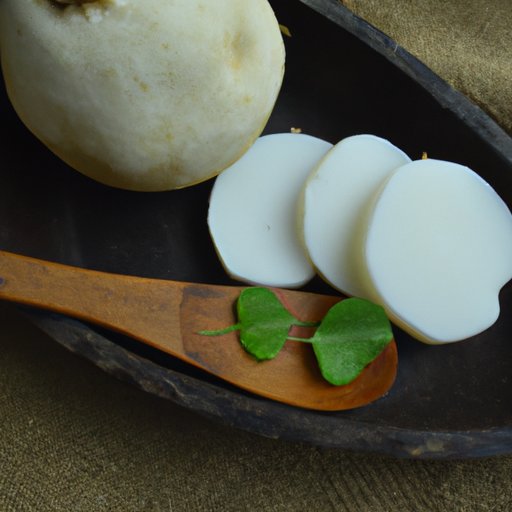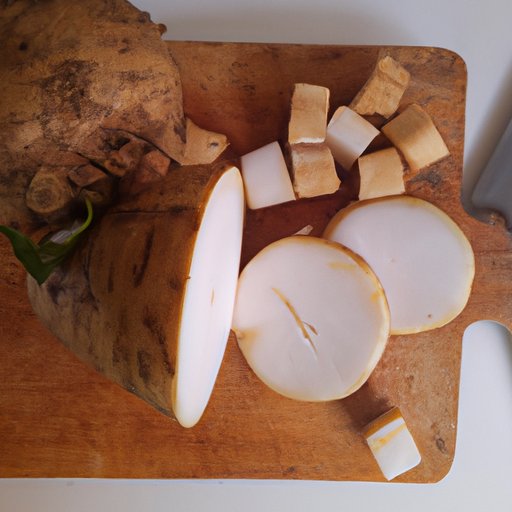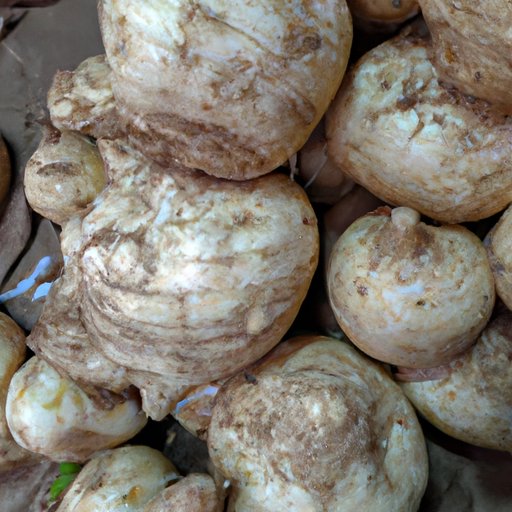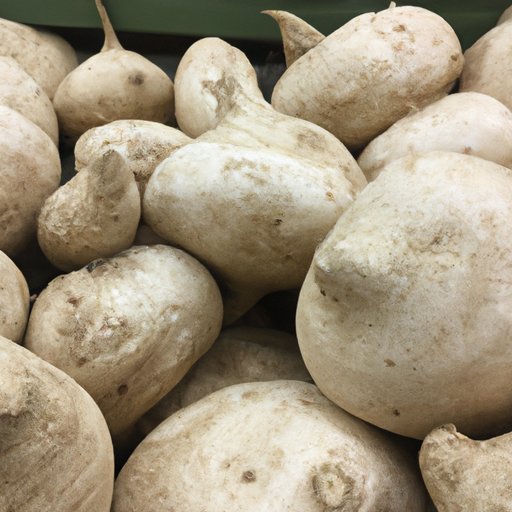Introduction
Jicama is a type of root vegetable native to Mexico and Central America. It has a crunchy texture and a sweet flavor, and is increasingly being used in salads, side dishes, and main dishes. But is jicama healthy? In this article, we will explore the nutritional benefits of jicama, as well as how to incorporate it into a healthy diet.

Exploring the Nutritional Benefits of Jicama
Jicama contains a variety of vitamins, minerals, and phytonutrients, which makes it an excellent addition to any meal. Let’s take a look at the macronutrients, micronutrients, and phytonutrients found in jicama.
Macronutrients
Jicama is a good source of carbohydrates, providing approximately 15 grams per cup (120 grams). It is also a good source of dietary fiber, with 6 grams per cup (120 grams).
Micronutrients
Jicama is a good source of vitamin C, providing 14% of the recommended daily value per cup (120 grams). It is also a good source of potassium, providing 10% of the recommended daily value per cup (120 grams). Additionally, jicama is a good source of folate, magnesium, and manganese.
Phytonutrients
Jicama is a good source of antioxidants, including quercetin, kaempferol, and chlorogenic acid. These antioxidants can help protect cells from damage caused by free radicals.

How to Incorporate Jicama Into a Healthy Diet
Jicama is a versatile vegetable that can be used in a variety of dishes. Here are some ideas for incorporating jicama into your diet:
Ideas for Salads
Jicama adds a crunchy texture to salads. Try combining jicama with other vegetables such as carrots, bell peppers, and cucumbers. You can also add fruits such as apples or oranges for sweetness. Finally, top your salad with a light vinaigrette dressing.
Ideas for Side Dishes
Jicama is a great addition to side dishes. For example, you can try roasting jicama with other root vegetables such as potatoes, carrots, and turnips. Or, you can make a slaw by combining jicama with cabbage and carrots. Add a light dressing of olive oil, lemon juice, and herbs for flavor.
Ideas for Main Dishes
Jicama can be used in a variety of main dishes. It pairs well with proteins such as chicken, fish, and beans. You can also use jicama in tacos, burritos, and fajitas. Finally, you can add jicama to stir-fries for a crunchy texture.
Is Jicama a Superfood?
A “superfood” is a term used to describe a food that is packed with nutrients and provides numerous health benefits. So, is jicama a superfood? Let’s take a look at why jicama is considered a superfood.
Definition of a Superfood
According to the Oxford English Dictionary, a superfood is “a nutrient-rich food considered to be especially beneficial for health and well-being.”
Reasons Why Jicama is Considered a Superfood
Jicama is a good source of vitamins, minerals, and phytonutrients, making it a superfood. Additionally, jicama is low in calories and high in dietary fiber, making it a healthy option for those looking to maintain or lose weight.

The Health Benefits of Jicama
Jicama offers numerous health benefits. Here are some of the potential benefits of eating jicama:
Supports Digestive Health
Jicama is high in dietary fiber, which helps to promote regularity and keep the digestive system running smoothly. A study published in the journal Nutrition Research found that increasing dietary fiber intake can reduce symptoms of constipation and improve overall digestive health.
Contains Antioxidants
As mentioned earlier, jicama is a good source of antioxidants, which can help protect cells from damage caused by free radicals. According to a study published in the journal Molecules, the antioxidants found in jicama have been linked to a number of health benefits, including anti-inflammatory and anti-cancer effects.
May Help Lower Blood Pressure
Jicama is a good source of potassium, which can help lower blood pressure. According to a study published in the journal Hypertension, increasing potassium intake can help reduce systolic and diastolic blood pressure.
May Be Beneficial for Weight Loss
Jicama is low in calories and high in dietary fiber, making it an excellent choice for those looking to lose weight. A study published in the journal Nutrition Reviews found that increasing dietary fiber intake can help promote weight loss.
Is Jicama a Low-Calorie Option?
Yes, jicama is a low-calorie option. One cup (120 grams) of jicama contains only 46 calories.
Calories in Jicama
One cup (120 grams) of jicama contains 46 calories, 0 grams of fat, 11 grams of carbohydrates, 6 grams of dietary fiber, and 1 gram of protein.
Other Low-Calorie Vegetables
In addition to jicama, there are other low-calorie vegetables that can be incorporated into a healthy diet. These include spinach, kale, celery, tomatoes, and mushrooms.
Comparing the Nutritional Profile of Jicama to Other Vegetables
Let’s compare the nutritional profile of jicama to other vegetables:
Macronutrients
Jicama is a good source of carbohydrates and dietary fiber, providing 15 grams and 6 grams per cup (120 grams), respectively. In comparison, potatoes provide 16 grams of carbohydrates and 2 grams of dietary fiber per cup (150 grams). Carrots provide 9 grams of carbohydrates and 3 grams of dietary fiber per cup (128 grams).
Micronutrients
Jicama is a good source of vitamin C, potassium, folate, magnesium, and manganese. In comparison, potatoes are a good source of vitamin C, potassium, and manganese. Carrots are a good source of vitamin A, vitamin C, potassium, and folate.
What Are the Healthiest Ways to Cook Jicama?
The healthiest ways to cook jicama include steaming, boiling, and roasting. Steaming preserves the most nutrients, while boiling and roasting can add flavor.
Steaming
Steaming is the healthiest way to cook jicama, as it helps to preserve the most nutrients. To steam jicama, add one inch of water to a pot and bring it to a boil. Place the jicama in a steamer basket and place it in the pot. Cover the pot and steam for five to seven minutes.
Boiling
Boiling is another healthy way to cook jicama. To boil jicama, add one inch of water to a pot and bring it to a boil. Add the jicama to the pot and cover. Boil for five to seven minutes, or until tender.
Roasting
Roasting is a delicious way to cook jicama. Preheat the oven to 375°F (190°C). Cut the jicama into cubes and place them on a baking sheet. Drizzle with olive oil and season with salt and pepper. Roast for 15 to 20 minutes, or until golden brown.
Conclusion
Jicama is a type of root vegetable that is gaining popularity for its many nutritional benefits. Jicama is a good source of vitamins, minerals, and phytonutrients, making it an excellent addition to any meal. Additionally, jicama is low in calories and high in dietary fiber, making it a healthy option for those looking to maintain or lose weight. Jicama can be eaten raw, cooked, or added to salads, side dishes, and main dishes. The healthiest ways to cook jicama include steaming, boiling, and roasting. To summarize, jicama is a nutritious superfood that can be easily incorporated into a healthy diet.
Tips for Adding Jicama to Your Diet
- Add jicama to salads for a crunchy texture.
- Roast jicama with other root vegetables for a flavorful side dish.
- Add jicama to tacos, burritos, and fajitas for a unique flavor.
- Steam jicama for the most nutritional benefit.
(Note: Is this article not meeting your expectations? Do you have knowledge or insights to share? Unlock new opportunities and expand your reach by joining our authors team. Click Registration to join us and share your expertise with our readers.)
